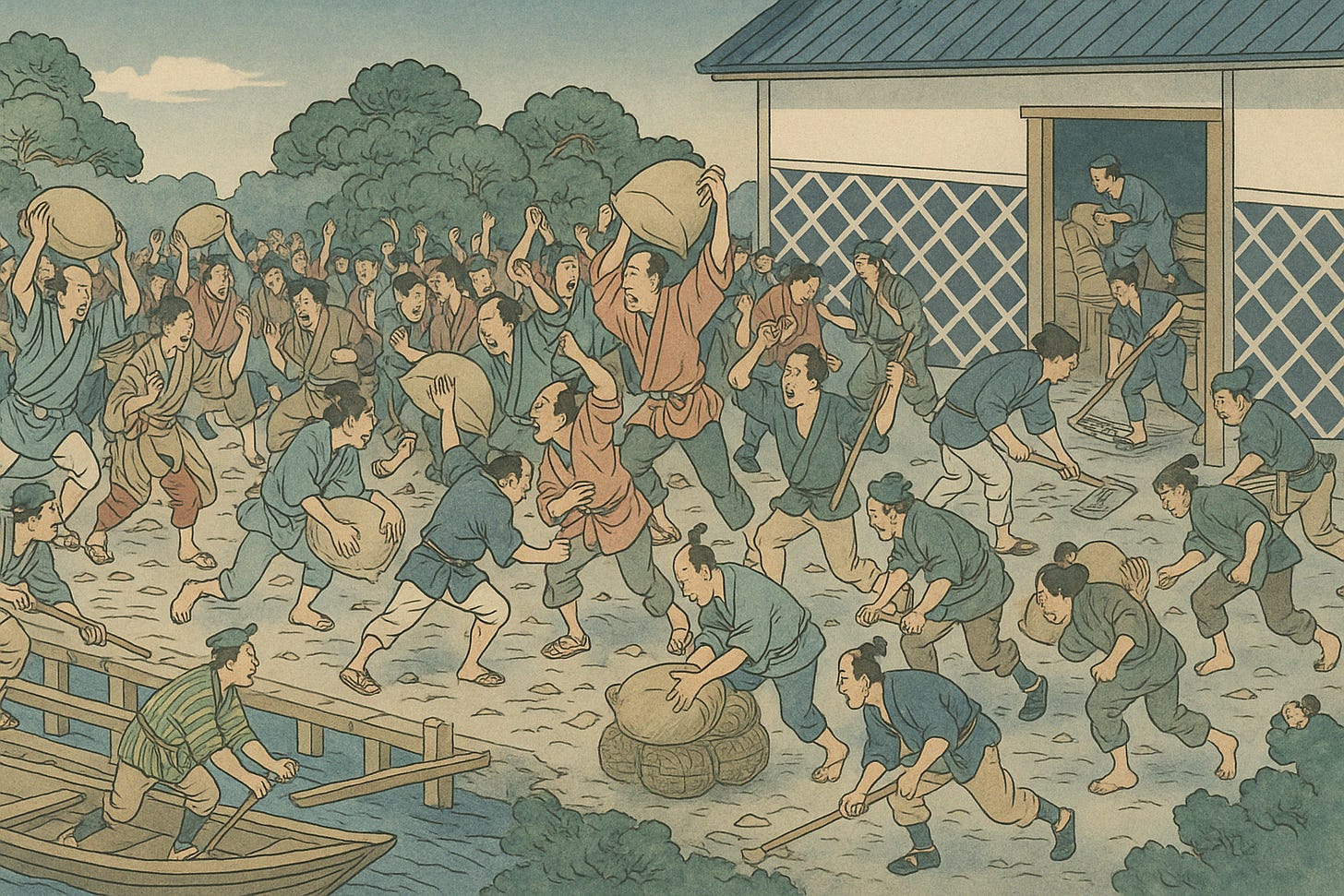Rice Prices Trigger Social Unrest
Rice Shortages And Historical Revolts
Readers may not realize it, but from 2024 to 2025 rice prices in Japan have shown an extraordinary surge, delivering a severe blow to daily life. This shortage and price spike were initially expected to ease once the new harvest hit the market in autumn, but in reality the crisis has only deepened across the turn of the year. For example, in the last week of March 2025 the average supermarket price for a 5 kg bag of rice climbed to ¥4,206—marking thirteen consecutive weeks of increases and more than double the price at the same time last year. As you know, rice is the staple food of the Japanese, and such a rapid run‑up in price has dealt a serious blow to household budgets and diets, already fueling widespread consumer frustration.
Yet strangely, rice remains abundant in government reserves known as reserve rice. Since late 2024 the Ministry of Agriculture, Forestry and Fisheries has been considering releasing these stocks to stabilize the market, and in February 2025 it finally decided to release approximately 210,000 tons—a move long demanded by consumers but implemented far too late. Even so, its impact on market prices has been limited: retail prices remain above ¥4,000 per 5 kg, and reports indicate much of the released rice has yet to reach store shelves. The government has now announced plans to release additional reserves monthly through autumn, but why has rice become such a flashpoint? Historically, any threat to rice supply has stirred widespread anxiety and evolved into anti‑government movements in Japan—a phenomenon known as rice riots (米騒動, kome sōdō).
Rice riots are, in short, large‑scale popular uprisings triggered by crop failures and soaring rice prices. This phenomenon began in the Edo period: during the Tenmei famine (天明の飢饉) of 1781–1789, farmers in the Hokuriku and Kantō regions—suffering from hunger and skyrocketing prices—frequently attacked rice granaries and the estates of village headmen, demanding price reductions. Pressured by these actions, feudal lords and the shogunate were forced to offer free rice distributions and tax relief. Later, during the severe Tempō famine (天保の大飢饉) of 1833–1837, peasant uprisings (百姓一揆, hyakushō ikki) and grain‑store riots erupted across the country, prompting the shogunate to impose price controls and distribute relief rice on a smaller scale.
According to historian Aoki Kōji, approximately 3,710 hyakushō ikki were recorded between 1590 and 1877, most protesting famine and rice price hikes. In Edo‑period villages, situations where “rice cannot be obtained” or “rice is too expensive” quickly escalated into social unrest and political crises, becoming one of the major factors leading to the shogunate’s decline.
The most severe rice riots occurred about a century ago in 1918, amid a post‑World War I boom that swelled urban populations while rice production lagged. Government plans for the Siberian Intervention sparked speculative hoarding, driving rice prices to nearly three times their level just two years earlier. On July 23, 1918, in the fishing village of Uozu, Toyama, fisherwomen protested rice exports by blocking shipments at the shore. Although initially dispersed by police, news of this “Echū women’s revolt” spread nationwide via newspapers. Between August 11 and 16, more than 400 riots erupted in every prefecture except Aomori, Iwate, Akita and Okinawa, involving some 700,000 participants from diverse social backgrounds. These spontaneous, leaderless uprisings culminated in large‑scale attacks on rice merchants in cities like Nagoya, Kyoto, Kobe and Tokyo—a nationwide popular revolt fueled by resentment toward monopolistic capital, landlord interests and wartime policies.
Faced with this unrest, the government’s delayed response mirrored today’s: emergency measures failed to curb prices, consumer anger intensified, and ultimately over 90,000 military personnel were deployed and more than 25,000 people arrested before the riots subsided in early September. Despite heavy‑handed suppression, public criticism forced the Terauchi Cabinet to resign on September 21, paving the way for Prime Minister Hara Takashi and ushering in the Taishō Democracy era.
Today’s crisis bears a striking resemblance: in a country where rice is more than food but a cultural cornerstone, any threat to its stable supply can ignite significant social change. The delayed release of 210,000 tons in February 2025 underscores how consumer pressure can compel policy action, yet its limited market impact highlights the need for more agile and transparent supply management. As tensions simmer, the lessons of past rice riots remind us that rice shortages are not merely economic issues but catalysts for profound social transformation.
I have lived in Japan for over thirty years, and recently I feel a disturbing atmosphere spreading across Japanese society that I have never seen before. Will the Japanese once again spark a modern rice riot? Every day I sense that a complex build‑up of people’s pent‑up anger and frustration has nowhere to go—but rice is merely the trigger, and no one can say where that energy will be directed. In recent years, anti‑immigrant sentiment among the Japanese has risen rapidly, and it’s important to note that various problems have already emerged.
Peaceful and safe Japan. That image we’ve taken for granted may not last much longer.



